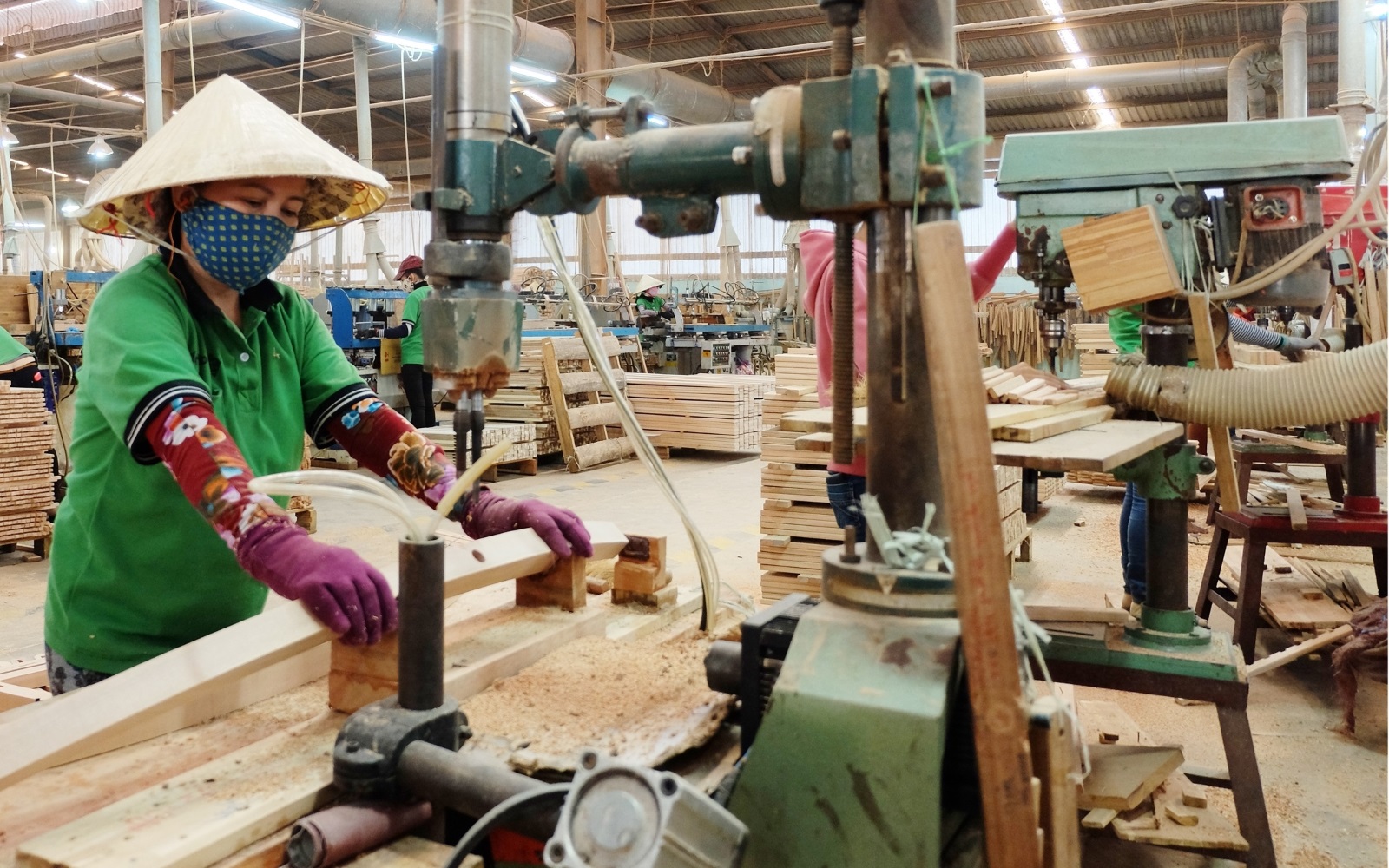Overview of Vietnam’s wood processing industry
The Vietnamese wood industry has undergone a remarkable transformation, evolving from a small craft sector into a global processing powerhouse. In recent years, it has experienced significant growth, even in the face of formidable challenges such as the COVID-19 pandemic. This industry’s journey is marked by adaptability, innovation, and a resolute commitment to sustainable practices.

The purpose of Vietnamese woodworking
Woodworking is a term that encompasses all types of work done with wood, including carving, joinery, and furniture making. Vietnamese woodworking is a centuries-old craft that has been used for a variety of purposes, from creating functional objects to expressing cultural identity. Woodcarvers in Vietnam use a variety of techniques and tools to create their work, and their creations are often highly prized for their beauty and craftsmanship. Here is the purpose of Vietnamese woodworking from a micro point of view:
- Functional Objects: Woodworking has been used to create a wide range of functional objects throughout Vietnamese history. Some of the most common examples include furniture, utensils, and tools. Vietnamese woodcarvers are known for their intricate and beautiful furniture, which is often made from rare and precious woods. They also create a variety of other functional objects, such as kitchen utensils, agricultural tools, and musical instruments.
- Decorative Objects: Woodworking has also been used to create decorative objects, such as sculptures, paintings, and jewelry. Vietnamese woodcarvers are skilled in creating intricate and detailed designs, and their work is often highly prized for its beauty and craftsmanship. Some of the most common motifs found in Vietnamese wood carving include dragons, phoenixes, and other mythical creatures.
- Works of Art: Woodworking can also be used to create works of art that are appreciated for their aesthetic value. Vietnamese woodcarvers are skilled in creating unique and creative pieces, and their work is often exhibited in galleries and museums around the world.
From a macro point of view, Vietnamese woodworking, once rooted in tradition, now stands as a testament to innovation and adaptability. It serves several vital purposes:
- Cultural Heritage Preservation: At its core, Vietnamese woodworking is a repository of cultural heritage. The craft has been passed down through generations, preserving traditional designs and techniques that tell the story of Vietnam’s rich history. Each intricately carved piece represents the embodiment of artistry and craftsmanship that defines Vietnamese culture.
- Cultural Identity: Woodworking has also been used to express cultural identity. Vietnamese woodcarvers often incorporate traditional Vietnamese motifs and symbols into their work, which helps to preserve and promote Vietnamese culture. For example, Vietnamese wood carvings often feature images of dragons, phoenixes, and other mythical creatures that are important in Vietnamese folklore.
- Economic Engine: Beyond its cultural significance, Vietnamese woodworking plays a pivotal role in the nation’s economy. It contributes significantly to the GDP by generating substantial revenue, offering employment opportunities for myriad artisans and laborers, and catalyzing export growth. Despite the challenges posed by the COVID-19 pandemic, wood businesses swiftly adapted to online sales and established strong connections with major markets.
- Global Sustainability: Sustainable practices are at the core of Vietnamese woodworking. Notably, a significant portion of wood products originates from plantation timber. This commitment to sustainability has not only contributed to the industry’s growth but has also positioned Vietnam as the second-largest wood and wood product exporter globally, following China.
The purpose of Vietnamese woodworking has evolved, but it continues to be an important part of Vietnamese culture and tradition. Woodworking is a skilled and time-consuming craft, and it is a testament to the creativity and ingenuity of Vietnamese artisans.

Read more: What are Vietnamese Wooden Sandals? Basic Features of Vietnamese Wooden Sandals
Vietnamese woodworking process stages
The Vietnamese woodworking process can be divided into the following stages:
Wood selection & sourcing
- Wood selection: The first step is to select the right type of wood for the project. Vietnamese woodworkers typically use a variety of woods, including teak, mahogany, rosewood, and bamboo. The type of wood will depend on the desired strength, durability, and appearance of the finished product.
- Sourcing Raw Materials: The first step in the woodworking process involves procuring raw materials, such as timber, from sustainable sources. Vietnam’s abundant forests provide a steady supply of wood for the industry.
Wood preparation
- Log Processing: Once the raw materials are sourced, they undergo log processing. This includes cutting, debarking, and preparing the logs for further treatment.
- Seasoning and Drying: Wood needs to be seasoned and dried to reduce moisture content. Proper drying is essential to prevent warping and ensure the quality of the final products.
Woodworking
The woodworking stage is where the wood is shaped into the desired form.
- Woodworking Techniques: Skilled craftsmen use various techniques like carving, shaping, and joining to create a wide range of wooden products. Traditional craftsmanship is often blended with modern technology for precision and efficiency.
- Quality Control: Rigorous quality control measures are in place to ensure that the final products meet international standards. This includes checking for defects, dimensions, and finish.
Finalizing
- Finishing and Assembly: Wood products are finished, polished, and assembled according to design specifications. This is where the products receive their final look and functionality.
- Packaging and Shipping: Finished products are carefully packaged to prevent damage during transportation. Vietnam’s strategic location allows for easy export to global markets.
The Vietnamese woodworking process is a complex and multi-step process that requires a high level of skill and precision. The use of traditional craftsmanship and modern technology ensures that the final products are of the highest quality and meet international standards. The strategic location of Vietnam allows for easy export to global markets, making Vietnamese wood products a popular choice for consumers around the world.

Things to note when Vietnamese woodworking
While Vietnamese woodworking offers numerous opportunities but also challenges, there are some important considerations to keep in mind:
- Sustainability: The industry’s commitment to sustainability is epitomized by its reliance on judiciously managed plantation timber. This sustainable ethos has contributed substantially to Vietnam’s ascent as a global woodworking paragon. But competition from illegal logging is a major problem in Vietnam, and it can undercut the prices of wood carving products made from legal timber. And woodcarving can harm the environment, such as by contributing to deforestation. Woodcarvers need to be aware of the environmental impact of their work and take steps to minimize it.
- Quality Assurance: Quality is an immutable imperative. But with a shortage of skilled woodcarvers in Vietnam, and those who are skilled are often in high demand. This can make it difficult to find someone to do high-quality work. Yet, The industry maintains unwavering vigilance over quality control standards, commencing from the selection of raw materials and culminating with the final, meticulous finishing touches. Every product must align harmoniously with international quality benchmarks to stake its claim in the fiercely competitive global market.
- Market Trends: Vietnamese wood carving is facing increasing competition from cheap imports from China and other countries. These imports are often made with low-quality materials and poor workmanship, but they can be sold for much lower prices than Vietnamese-made products. And the cost of raw materials, such as wood, is rising in Vietnam. This makes it difficult for woodcarvers to make a profit on their products. However, Vietnamese wood enterprises have not only weathered adversity but have thrived amidst it. In the crucible of the pandemic, they deftly adapted to the digital realm of online sales, forging robust connections with major markets. This spirit of adaptability positions them felicitously to navigate future challenges.
- Compliance: Adherence to international regulations and certifications emerges as a sacrosanct principle, particularly for exporters. Ensuring the alignment of products with the exacting requisites of target markets, encompassing safety and environmental standards, embodies a cardinal aspect of the industry’s creed.
- Innovation: To perpetuate its astounding growth trajectory, Vietnamese wood enterprises must ardently focus on design, branding, and the cultivation of a fertile terrain for creative product development. This zealous commitment to innovation and creativity shall remain their lodestar, ensuring they continue to shine brightly on the global stage.
- Difficulties in marketing and exporting: Vietnamese woodcarvers often face difficulties in marketing and exporting their products, which can make it difficult to compete in the global market. This is due to several factors, including language barriers, high shipping costs, and lack of knowledge about international markets.

Vietnam wood processing technology
Woodworking evolved from manual craftsmanship to incorporating machinery, increasing efficiency and production. The modernization of Vietnamese woodworking owes much to cutting-edge technology:
- Advanced Machinery: Vietnam’s woodworking facilities have embraced state-of-the-art machinery. Computer numerical control (CNC) machines, laser cutters, and precision tools have revolutionized production processes. These technologies enable artisans to create intricate designs with unparalleled precision.
- Computer-Aided Design (CAD): CAD software has become an integral part of the design phase. It allows designers to conceptualize and refine their ideas with remarkable ease. This technology not only enhances creativity but also facilitates collaboration with international clients.
- Automation: Automation has streamlined production lines, increasing efficiency and minimizing errors. Automated processes for cutting, shaping, and finishing have significantly reduced the time required to craft wood products while maintaining the highest quality standards.

In conclusion
Vietnamese woodworking is not merely an industry; it’s an ode to resilience, innovation, and sustainability. Its purpose transcends the mere crafting of wooden products; it encompasses the preservation of cultural legacies, economic ascension, and global stewardship that exemplifies sustainable practices. With technology as its vanguard, and a steadfast dedication to quality, sustainability, and innovation, Vietnam’s wood processing industry is poised for a future of ever more resplendent horizons.
Read more: What is a Vietnamese Wooden Bed? 8 Type of Wood for Making Beds in Vietnam




